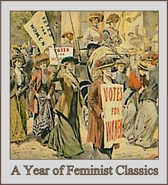Reviewed by Ingrid
Published: 2010
It's about: This book is the story of Irene America, her husband Gil, and the slow unraveling of their marriage. Gil is an artist, and his series of portraits of his wife have become famous. To others, their marriage is iconic, but in truth they have begun to resent each other. In order to manipulate her husband, Irene begins writing a fake diary - the Red Notebook - that she knows her husband will read. Her real diary, the Blue Notebook, she keeps locked in a safe deposit box. The narrative moves between entries in each notebook and a third person who is revealed at the very end.
I thought: I've had this book on my radar for awhile, but I kept putting off reading it because I didn't think the topic would interest me. However, I think a great writer is able to draw you into her story, no matter what the topic - and that is exactly what happened with me. This book was short, the font was big, it was divided into very short sections, yet it was one of the most deeply, painfully emotional books I've ever read. Erdrich beautifully depicts the complexities of this relationship, wringing out painful truths from the most prosaic events.
I have to say, I'm very drawn to heart wrenching, tragic stories like this one. Ever since I finished this book I've been thinking about why this is so. I've concluded that I honestly believe that the most beautiful things in life and in art (and in literature) come from the darkest, most painful experiences.
I'm very interested to know - are you like me, do you find the most beauty in tragic, sad things? Or do you think more uplifting, light-hearted, and/or funny literature can be just as beautiful?
Verdict: Stick it on the shelf.
Warnings: Some swear words, a few sex scenes. A lot of "Adult Content." Is that too vague? It's nothing gratuitous, but I wouldn't recommend this to younger readers.
Favorite excerpts: "Gil was working out the paintings, the colors, the emotion, and as he did he was happy. He did not feel alone when he was working. Even when things weren't going so well otherwise, he could paint. It didn't even matter if Irene was angry. In fact, it was better. When they were happy, when he could count on her quotidian devotion, the paintings seemed to veer into insipidity. He had to wrestle with contentment. As she moved away from him emotionally, the paintings grew fiercer. They came alive with longing. He painted her pain, her elusiveness, his grasping clutch, her rejection, his bitter hope, her sullen rage into the pictures. He'd become aware that the worse things were between them, the better his work came out. It did not yet occur to him to wonder whether his suspicions about Irene were also a method of pushing her away from him, so that he could feel her absence, and in turn feel an aching desire out of which he could make his art."
What I'm reading next: Cold Mountain by Charles Frazier. Oh yeah and I'm still working on that Proust biography.
Published: 2010
It's about: This book is the story of Irene America, her husband Gil, and the slow unraveling of their marriage. Gil is an artist, and his series of portraits of his wife have become famous. To others, their marriage is iconic, but in truth they have begun to resent each other. In order to manipulate her husband, Irene begins writing a fake diary - the Red Notebook - that she knows her husband will read. Her real diary, the Blue Notebook, she keeps locked in a safe deposit box. The narrative moves between entries in each notebook and a third person who is revealed at the very end.
I thought: I've had this book on my radar for awhile, but I kept putting off reading it because I didn't think the topic would interest me. However, I think a great writer is able to draw you into her story, no matter what the topic - and that is exactly what happened with me. This book was short, the font was big, it was divided into very short sections, yet it was one of the most deeply, painfully emotional books I've ever read. Erdrich beautifully depicts the complexities of this relationship, wringing out painful truths from the most prosaic events.
I have to say, I'm very drawn to heart wrenching, tragic stories like this one. Ever since I finished this book I've been thinking about why this is so. I've concluded that I honestly believe that the most beautiful things in life and in art (and in literature) come from the darkest, most painful experiences.
I'm very interested to know - are you like me, do you find the most beauty in tragic, sad things? Or do you think more uplifting, light-hearted, and/or funny literature can be just as beautiful?
Verdict: Stick it on the shelf.
Warnings: Some swear words, a few sex scenes. A lot of "Adult Content." Is that too vague? It's nothing gratuitous, but I wouldn't recommend this to younger readers.
 |
| Louise Erdrich. Isn't she beautiful? I hope my kids look like this. |
What I'm reading next: Cold Mountain by Charles Frazier. Oh yeah and I'm still working on that Proust biography.









